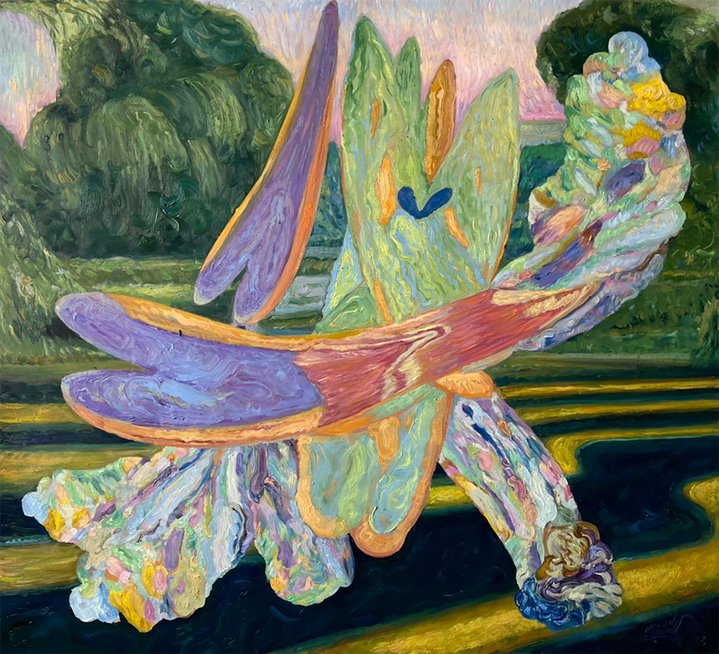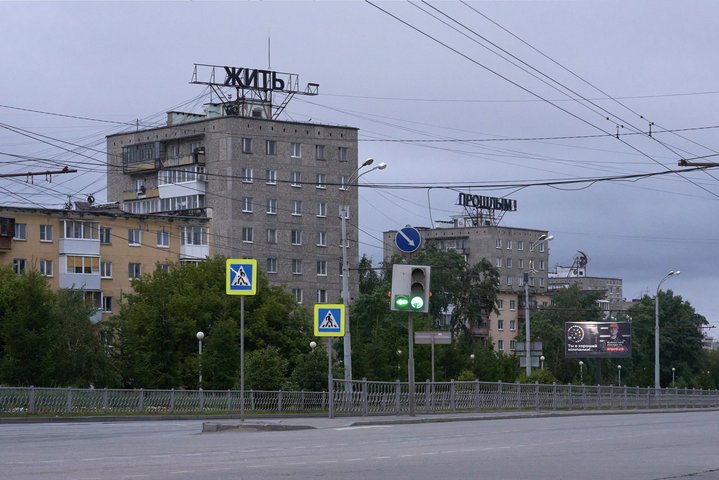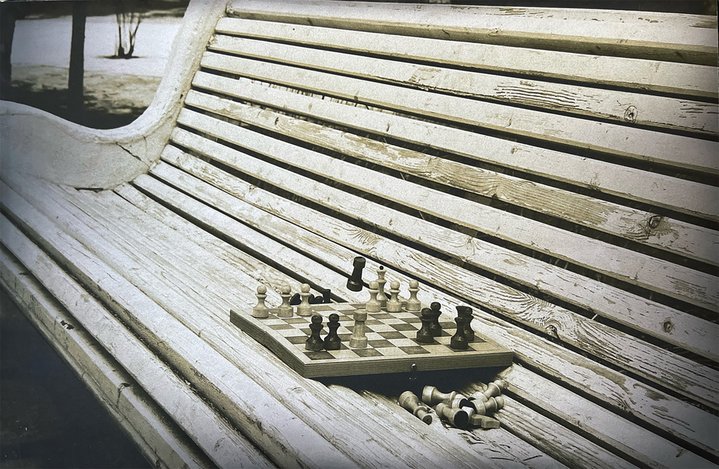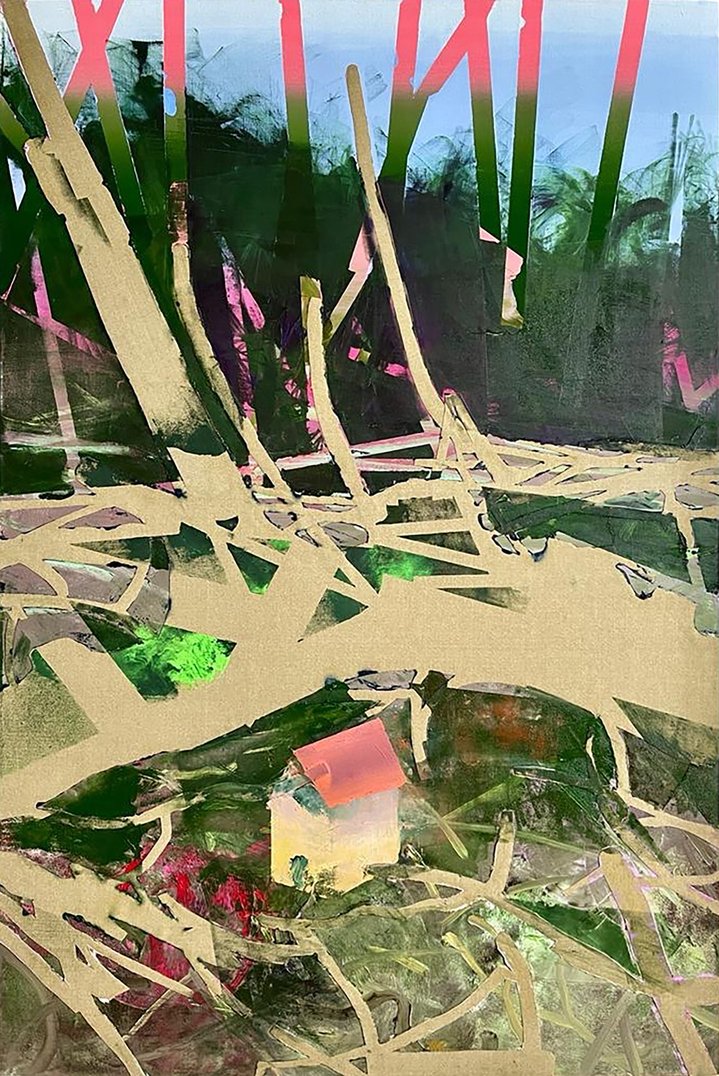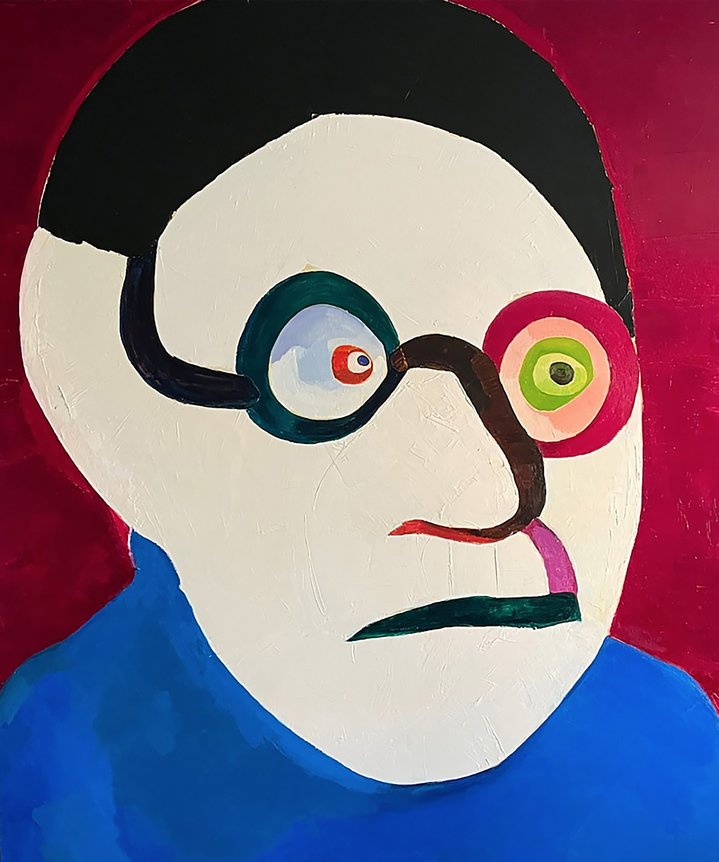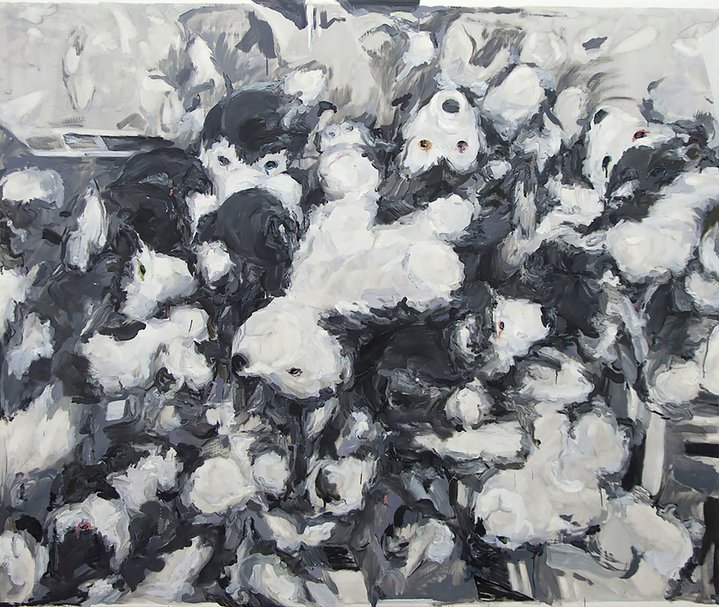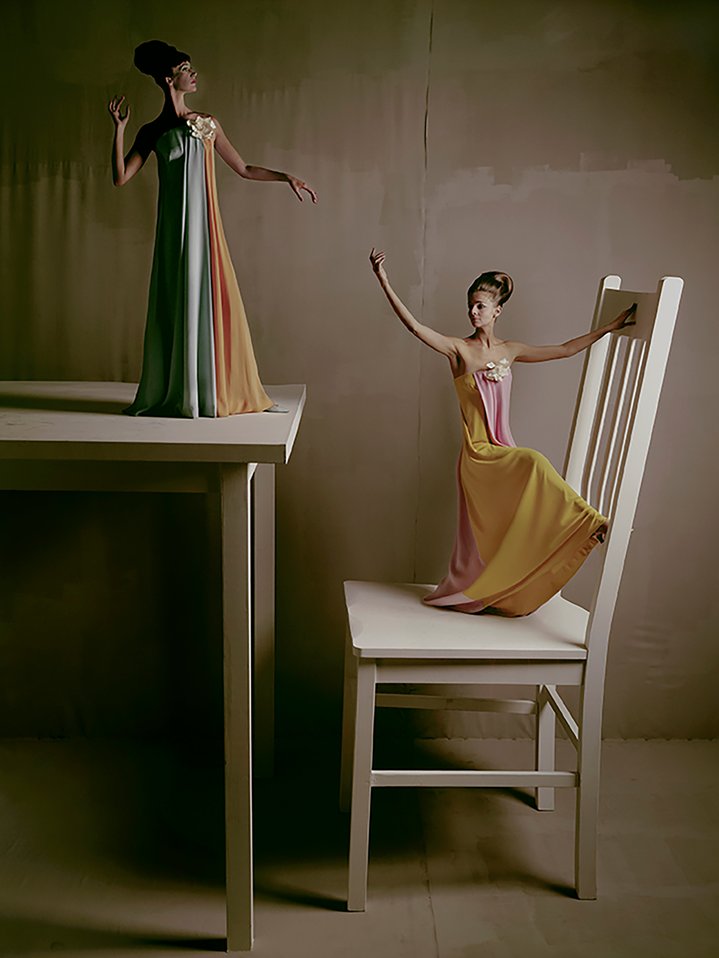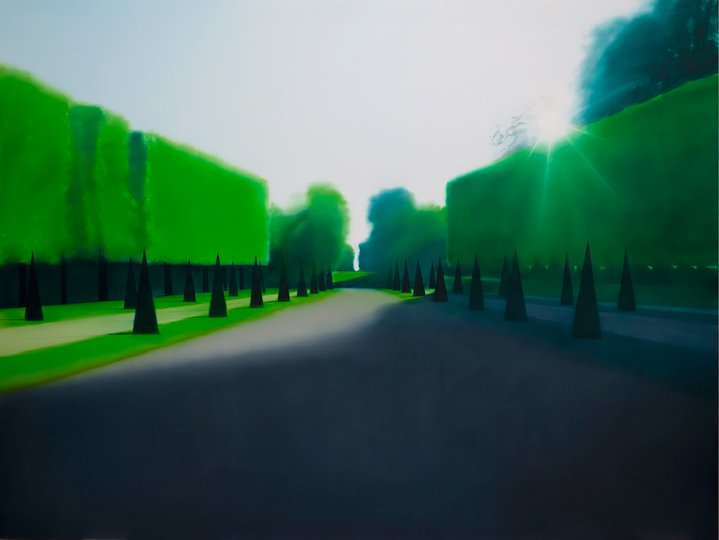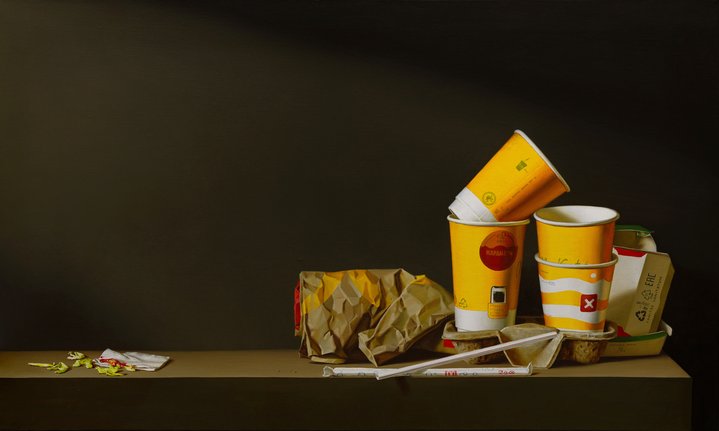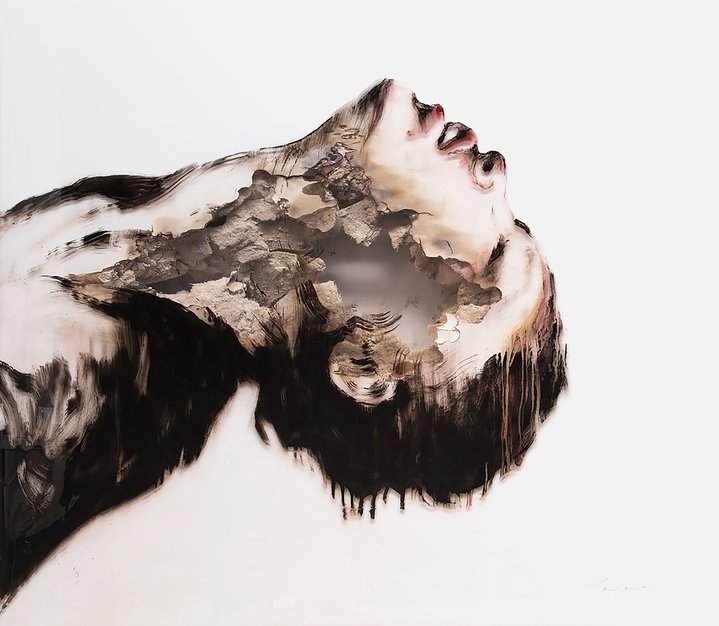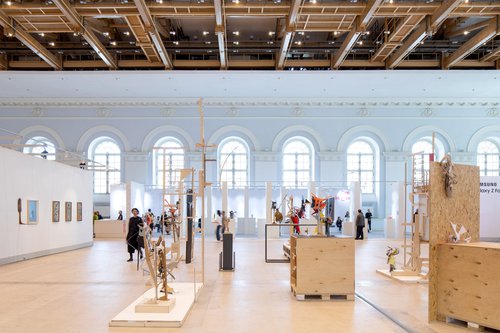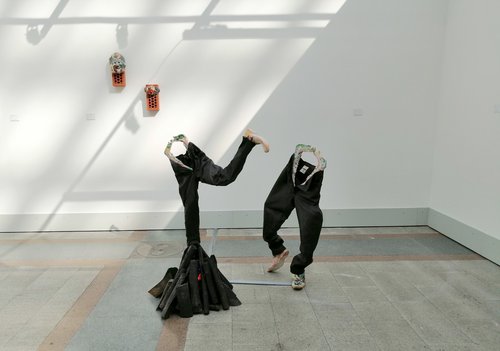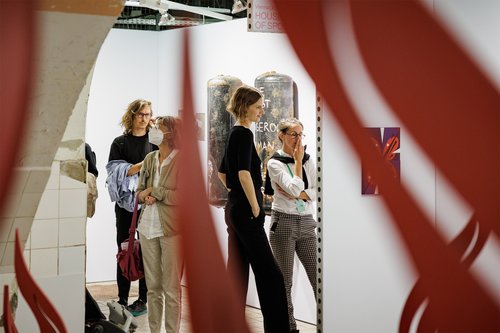Cosmoscow 2022. Photo by Nikita Berezhnoy
Cosmoscow art fair: Russian market on the brink of the unknown
Russia’s leading contemporary art fair, Cosmoscow runs from 15th to 17th of September and until 25th September online. Billed as an international art fair, this time there were no galleries from abroad.
Near the entrance to the fair, Moscow’s Artwin gallery, which has no permanent physical space, attracted attention with a curious display. In their booth, works were stacked against the walls on a low podium as if the installation had been stopped suddenly, or as if they were about to be packed up for shipping. Perhaps this in-between state is the perfect metaphor of the Russian art market in general. The centrepiece of their ensemble was a TV screen showing a video documentation of an ephemeral piece of street art by Tima Radya (b. 1988). In June, he constructed giant letters on the rooftops of two residential buildings in his hometown of Ekaterinburg where dormant advertising structures were asking to be filled with something. The letters written in the font of a typical Soviet propaganda slogan, said: Жить прошлым! (Live in the past!) This timely slogan fitted so perfectly into the city skyline that it came to the notice of the authorities who removed it only two days later.
The fair was as crowded as usual on the opening night and people were in the mood to buy, gallerists reported brisk sales. You could see red dots everywhere even as early as 6pm on the preview day. A similar level of enthusiasm among buyers was felt at Blazar, Cosmoscow’s satellite fair for young art, the day before. The gallerists juggled casually with seven-digit figures, quoting prices in Roubles instead of US Dollars and Euros, which had been the default currencies on the domestic Russian art market over the past thirty years. There were still some dealers with certain works on their booth priced in dollars and others in Roubles. Elvira Tarnogradskaya from the Syntax Gallery explained this approach on her stand: ‘one of my artists lives in America and the other in Russia’. The A-s-t-r-a gallery offered museum quality large scale paintings by Natalia Turnova (b. 1957) at 20,000 Euros and smaller paintings by the same artist at 300,000 Roubles.
Those dealers who quoted their prices in foreign currencies seemed to be unsure about the exchange rate. It’s understandable as the current official rate at less than 60 Roubles for both one Euro and one Dollar, is far from the actual mid-market rate. In addition, withdrawing cash in foreign currencies from bank accounts has been banned in Russia, wire transfers to and from foreign banks are risky and complex and the import of Euros in cash has been banned by the EU. ‘We are in the rouble-only zone now’, Alexander Sharov, the owner of 11.12 gallery reflected.
One of the most expensive works in the fair was an enormous brightly-coloured work on card by Valery Koshlyakov (b. 1962) depicting an African landscape. It was on offer by the Heritage gallery for 120,000 Euros. The Syntax gallery was asking 70,000 US Dollars for a painting titled ‘Coca-Cola – this is my blood’ by New York based Sots Art veteran Alexander Kosolapov (b. 1943). According to the gallery owner Elvira Tarnogradskaya, another painting by him ‘Red Caviar’ was sold for 50,000 US Dollars in the first few hours of the preview. Moscow’s JART gallery offered two recent paintings by Pavel Pepperstein (b. 1966) at 55,000 US Dollars each, while Didi gallery from St Petersburg offered a painting by painter Evgeny Mikhnov-Voitenko (1932-1988) one of the first champions of post-war abstraction in USSR for 35,000 Euros.
The section of editions was led by Piranesi LAB, a top end, long established printing shop well known by insiders of the Russian art market. It is famous for its collaborations with blue-chip Russian artists and produces limited edition silkscreen prints commissioned by private art institutions, such as Garage and GES-2.
This year, its owner Alexey Veselovsky decided to take his own booth at the fair where he was offering the last project of late Moscow artist Nikita Alexeev (1953–2021). A 27 page series called ‘Your First Book’, conceived as a conceptual ABC to be coloured in by children, with three copies coloured by the artist himself, was on sale, each for one million Roubles.
The overall mood of the fair has changed dramatically from prior editions where there seemed to be a youthful optimism and preference for all things flashy and colourful. This gave way to a somewhat deeper and more pensive approach to reality. Even the award for the best booth went to a top St.Petersburg art dealer Marina Gisich who was showing enormous, grim paintings by Pyotr Shvetsov (b. 1970) which took up most of the wall space.
The Collector’s Eye section brought together works from the vaults of two art collectors from St Petersburg, Denis Khimilyaine and Sergei Limonov. This carefully curated displayed offered an unflattering picture of Soviet history whose lessons have apparently not been learned in contemporary Russia. There was a drawing by the Gulag inmate Boris Sveshnikov (1927-1988), a model for a monument to war victims by Vadim Sidur (1924-1986), Haim Sokol’s (b. 1973) documentary project on paper factory workers who became victims of repression, all eerie milestones leading to an ominous climax in Alexander Gronsky’s (b. 1980) photographic triptych ‘Reconstruction. Saint Petersburg’, a Breughelian depiction of present-day Russians re-enacting a battle of World War II in a public park on a winter weekend.
Another St Petersburg dealer, Nikolai Evdokimov turned his booth into a total installation made out of works by artist Dmitri Sirotkin (b. 1959). It showed traditional culture, represented by the Hermitage Museum, falling apart under harsh winds of a new reality. The project was called ‘The End of History’, and the institutional critique all the more striking as the artist was once a staff photographer of the Hermitage and had a solo exhibition at its General Staff annex. Ironically, the Hermitage’s own booth, named ‘Museum of the Year’ by Cosmoscow, was located just a few steps away.
Pro Art’s gallery from Kaluga struck a somewhat lighter note with another topical installation. In his solo display artist Viсtor Ponomarenko (b. 1987) was apparently aggrieved over the decision of MacDonald’s to quit Russia. The Russian assets of the global fast-food chain were subsequently sold to a local owner who re-branded it into Вкусно и Точка (Tasty and That’s It!), the restaurants re-opening with a new logo and a similar menu. Ponomarenko’s paintings depict familiar MacDonald’s packaging yet empty, discarded and deprived of its logo. Was it merely dark humour or the desire for a new identity that stretches far beyond fast food alone, one could not help wondering.






